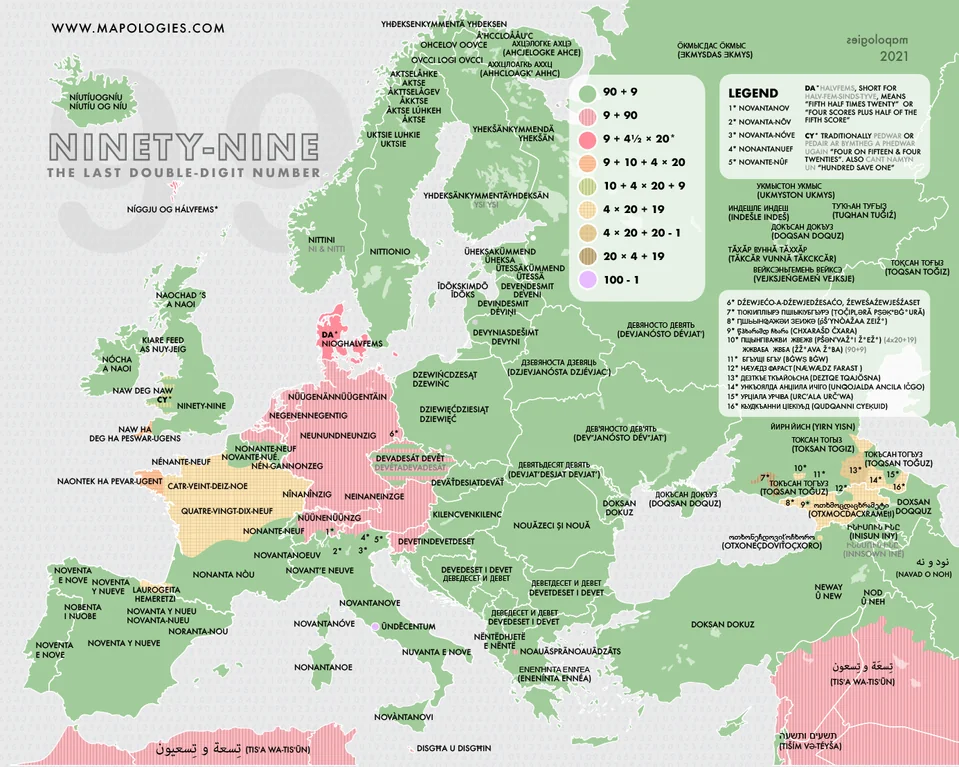Denmark over here adding fractions and shit...
YUROP
A laid back community for good news, pictures and general discussions among people living in Europe.
Other European communities
Other casual communities:
Language communities
Cities
Countries
- !albania@lemmy.world
- !austria@feddit.org
- !belgique@jlai.lu
- !belgium@lemmy.world
- !croatia@lemmy.world
- https://feddit.dk
- !deutschland@feddit.org / !germany@feddit.org
- !eesti@lemm.ee
- !spain@lemuria.es
- https://lemmy.eus/
- !finland@sopuli.xyz
- !france@jlai.lu
- https://foros.fediverso.gal/
- !greece@lemmy.world
- !hungary@lemmy.world
- Italy: !news@feddit.it
- !ireland@lemmy.world
- !northern_ireland@feddit.uk
- !norway@lemmy.world
- !thenetherlands@feddit.nl
- Poland: !wiadomosci@szmer.info
- !portugal@lemmy.pt
- !romania@feddit.ro
- !suisse@lemmy.world
- !sweden@lemmy.world
- !ukraine@sopuli.xyz
- !unitedkingdom@feddit.uk
- !wales@lemm.ee
Yeah, this problem comes up with 50, 60, 70, 80 and 90 in Danish, because those are counted in "number of twenties" for some reason. And not like "3-and-a-half-twenties" but rather "halfway-towards-the-fourth-twenty". That example is 70 by the way (halfjersindstyvende). And nowadays it's shortened to omit the "twenties"-part. So in this case just "halvfjers".
The naming convention is pretty whack, but it's just treated as irregular naming in normal use. The alternative, would be to rename those numbers to femti, seksti, syvti, otteti, and niti, but that's very much an uphill battle against habit. So for now. 50, 60, 70, 80, and 90 just have unique names...
Yes they really didn't want to go the easy way
Yeah, and it's wrong.
Nioghalvfems is 9 + 1/2 * 5 * 20!
NOT that silly 9+(4+1/2)*20.
What do they take us for? Calculators?
9 + 1/2 * 5 * 20
9 + 2.5 * 20
9 + 50
59?
How does nioghalvfems make 99?
The graphic is correct. "Halvfems" is shorthand for "halvfemsindstyvende" which roughly means; halfway to the fifth twenty. So 4,5 or 4-1/2 "twenties" so 90. But nobody rally thinks about that. To most Danes "halvfems" is just the name for 90, just like ninety is in English...
It should rather be 9 + (5 - 1/2) * 20. Halvfems is halfway from 4 to 5, but the 5 is the value explicitly mentioned
Yes. That is what i said? "Halfway to the fifth" which i clarified to mean 4,5 in this context, so as to not be confused to mean 2,5.
Yeah 5-1/2 is 4.5, but the word "fems" is short for femsindstyvende, which means 5x20, so writing it out as (5-1/2) rather than 4.5 matches the word halvfems more closely. Could also write it out as (-1/2 + 5) i suppose
Not Dane here but I know this:
"fems" is "five twenties"
"halvfems" is "halfway (between 4*20 and) 5*20" = 90
But don't forget that 100 has its own word and isn't fems, still 90 is halvfems.
Who says 100-1? I can’t find the lilac on the map, but it seems very reasonable and I support this.
A small point in the middle of italy. Maybe the vatican?
Latin has two ways to express it:
- undecentum (which reflects the numeral notation "IC"), meaning 100 - 1;
- nonaginta novem, plain regular form 90 + 9.
Thank you!
For people asking why France is split, they used Occitan for the southern part, which I think is an interesting choice to show the regional language even if most people don't speak it.
Not ideal, though. A mixed area would have been better. Acknowledging Occitan is important but it gives the false impression that a majority speaks it. And it goes way too north.
It seems to go that north because it includes the local language west of Switzerland? You see the Nonante-neuf overlapping
So, are we (Czechia) the only ones who use more than one way?
90+9 (ninety-nine literally) is the formal way to do it, while 9+90 (nine-and-ninety literally) is the informal way. You can easily hear both of the ways used in one sentence.
Norway as well. 90+9 is the official way, 9+90 is the way from when the Germans occupied the country. Both are still used. The map also says Georgia and Finland also use two variations.
The Finnish colloquial variation on the map – ysiysi – is "nine nine"
I thought ni og nitti was just favoured by people who use nynorsk.
It's favored by people over 60 and those who have parents that use it constantly, basically.
9 and 90 appears in English but reads extremely archaic, you'd basically never run into it in modern speech.
Niti og ni, 9*10+9 was used in Danish on cheques.
I doubt those exist anymore, though.
Only sane ones are 90+9, 9+90 and 100-1
Variations of 4 x 20 + 19 are fine too. It's the same as 90+9 (9 x 10 + 9) but using base 20 instead of 10
It's the Danish who are wrong
Nah, changing bases from one number to the next while counting up is a step too far.
Hey! I resemble that remark!
Wow, I’ve never seen one of these maps that included Sámi languages. I’m impressed.
